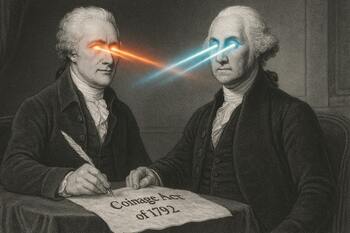
Long before fiat currency, digital dollars, or cryptocurrency, America’s Founders sought to anchor the young nation’s economy in gold and silver, i.e. sound money.
In fact, on April 2, 1792 – 233 years ago – President George Washington signed legislation that established America’s monetary system.
Also known as the Mint Act and officially titled An Act Establishing a Mint and Regulating the Coins of the United States, The Coinage Act of 1792 is regarded as one of the most foundational laws in U.S. history.
Of the Founding Fathers, Thomas Jefferson, James Madison, John Adams, and George Washington each advocated that gold and silver coins should be the money of the nation.
America’s first Treasury Secretary and fellow Founding Father, Alexander Hamilton, advocated for a hard-metal standard and helped design the U.S. dollar based on the widely circulated Spanish milled dollar—also known as the “Spanish real” or “pieces of eight.”Before authoring the Coinage Act, Hamilton warned in 1790, “To emit an unfunded paper as the sign of value, certainly has some advantages of a temporary nature, but it is calculated to produce great mischiefs in the long run.”
It was this seminal sound money law that established the United States Mint in Philadelphia, created a decimal currency system, defined U.S. coins by weight and metal, and authorized a gold and silver standard. It followed the intent of the Constitution itself.
When people refer to “Constitutional money,” they are referring to gold and silver coins.
Article 1, Section 8, Clause 5, of the US Constitution, says of the federal government, “Congress shall have Power... to coin Money, regulate the Value thereof, and of foreign Coin, and fix the Standard of Weights and Measures.”
Article 1, Section 10, Clause 1, says of the states, “No State shall... make any Thing but gold and silver Coin a Tender in Payment of Debts.”
The Coinage Act of 1792 codified this Constitutional wording, establishing gold and silver coins (also known as specie) as official tender instead of paper currency or fiat currency.
The Coinage Act went further by legally fixing the gold-to-silver ratio at 15:1 (meaning 15 ounces of silver is equal to 1 ounce of gold) and then pegged the U.S. dollar (denominated in gold and silver) to this ratio. This bimetallic standard, also known as bimetallism, defined the country’s currency by two precious metals, i.e. gold and silver. It created a uniform and stable coinage system that could compete on an international scale.
For $1 silver coins, the weight was set at 371.25 grains of pure silver, or 416 grains of standard silver (≥89.24% pure silver). This equals around 0.7734 troy ounces of pure silver or 0.8667 troy ounces of standard silver. These weights and purity corresponded with the popularly circulated Spanish reales (“pieces of eight”), which had around 377.1668 grains of pure silver (24.44 grams).
For $10 gold Eagles, the standard weight was 247.5 grains of pure gold, or 270 grains for standard gold (≥91.67% pure gold). This equals around 0.5156 troy ounces of pure gold or 0.5625 troy ounces of standard gold. These measurements were based on the popular coins of the day, including the Spanish 8 escudos doubloon.
With money made from gold or silver, inflation was almost non-existent, the government was far more restricted, and people were able to afford more with less while paying off debts and planning for the future.
Since 1792, there have been at least a dozen changes to the U.S. currency and monetary system, essentially redefining the meaning of the U.S. dollar. The changes were often slow and methodical, but simultaneously detrimental and the antithesis of everything the Constitution and the Founders intended.
The country abandoned bimetallism through the Coinage Act of 1873, widely known as “The Crime of ‘73,” by demonetizing silver as a part of the monetary system. Then in 1900, the country established a gold-only standard under the Gold Standard Act.
By 1933, the U.S. would no longer embrace gold at all, at least domestically, and this would lead to a heavy devaluation of the purchasing power of USD. Per government statistics, this equates to around 96.02% loss of purchasing power since 1933.
In 1965, silver was eliminated from coins, and by 1971, the country adopted a fully fiat currency. $1 purchasing power in 1971 now requires around $8. This means USD has lost around 87.5% purchasing power since 1971.
The monetary policy shift away from gold and silver Constitutional sound money to fiat currency has created widespread adverse inflation, a tyrannically unaccountable governing body, and the cost of living and properly planning for the future has become oppressively burdensome.
The Founders and the Constitution warned against this very thing, which is why Congress established the Coinage Act of 1792.
While this demonstrable currency debasement is an ongoing federal battle, Money Metals and the Sound Money Defense League have been actively fighting to restore sound money policies at the state level since 2014. Together, they have been consistently working to restore the sound money principles enshrined in the Constitution and the Coinage Act of 1792.
In 2024 alone, the Sound Money Defense League directly helped seven states enact sound money policies supporting gold and silver as sound money. These vital steps are bringing us closer to reestablishing gold and silver as honest and reliable money.
To get informed or involved with this grassroots sound money movement and a return to Constitutional money, stay connected with Money Metals and the Sound Money Defense League.
Originally Published on Money Metals.



